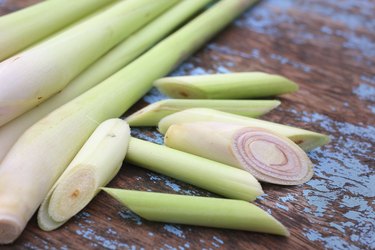Things You'll Need
Two 1-quart canning jars
4 to 5 lemon stalks or more as desired for potency
Double boiler
Wine press
Quart-sized or larger glass jug or container
Mortar and pestle or rolling pin
1 quart almond, coconut or grapeseed oil
Cheesecloth
Brown or blue glass bottles with lids for storage

Lemongrass harvested from your herb garden and turned into an oil makes a homemade topical solution you can use to treat certain fungal infections and inflammation. You can also apply it as a topical bug repellant, but test the skin for sensitivity before use, as overuse of any essential oil can cause skin reactions. Avoid getting lemongrass essential oil in the nose, eyes, ears and mouth. With many species of lemongrass available, the most commonly used are Cymbopogon citratus and Cymbopogon flexuosus; the latter is preferred to create an essential oil.
Cold Infusion Method
Step 1
Cut up two lemongrass stalks and crush them with the mortar and pestle to release the oil. If you don't have one, a rolling pin makes an effective substitute.
Video of the Day
Step 2
Add the crushed lemongrass stalks to the jar and cover them with oil. Place an airtight lid on the jar and store it in a sunny location for two days. Choose a spot that receives ample sunlight and heat throughout the day.
Step 3
Strain the lemongrass oil through cheesecloth after two days into the second quart jar. Cut up two more lemongrass stalks and crush them as you did in Step 1 before adding to the second quart jar. Place back in the sun for two more days.
Step 4
Repeat these steps as needed until the lemongrass reaches the desired level of potency testing by smelling it.
Step 5
Drain the lemongrass through cheesecloth into dark brown or blue bottles for storage. Tightly fasten the lids on the bottles and place them in a cool, dark place, such as a pantry, for storage.
Hot Infusion Method
Step 1
Remove the top of a double boiler; add hot water to the lower pan; place it on the stove and turn on the heat to bring it to a boil.
Step 2
Cut up all the lemongrass stalks and combine them with the oil in the top of the double boiler. Place the top of the double boiler over the bottom when it has reached a roiling boil.
Step 3
Heat the oil and lemongrass over the double boiler gently for about three hours.
Step 4
Set the wine press on an elevated surface and arrange it so that its bottom -- fitted with a clear plastic tube -- strains into a jug.
Step 5
Fit the cheesecloth to the rim of a wine press securely. Strain the lemongrass oil through the wine press and cheesecloth.
Step 6
Fill dark brown or blue storage bottles with the lemongrass essential oil. Cover with lids and store in a cool, dark place.
Tip
While the lemongrass is stored in a cool, dark place, you can use it for up to 12 months before it begins to break down.
If you do not store the lemongrass in dark bottles in a cool place, it won’t last every long, as the ultraviolet rays reduce its effectiveness with time.
Make certain that you heat the lemongrass stalks and oil gently over the double boiler for three hours; do not let the lemongrass and oil come to a boil on the top of the double boiler.
Warning
Consult a doctor before using lemongrass on children, the elderly, pregnant or nursing women, as it can cause skin rashes for those with such sensitivities.
While there are edible versions of lemongrass used in cooking, lemongrass essential oil is for topical use only, not for adding to foods or ingesting.
Video of the Day